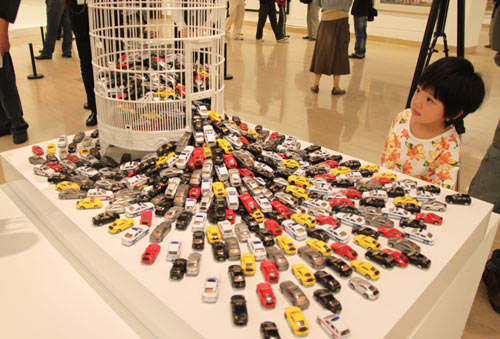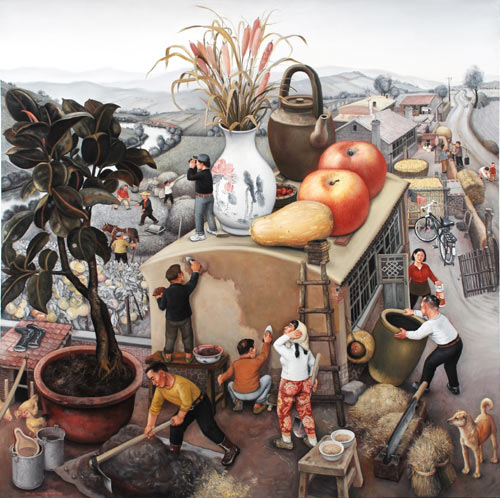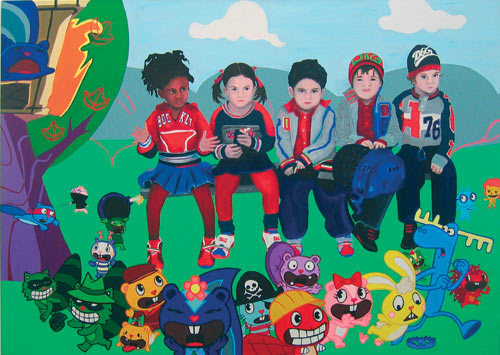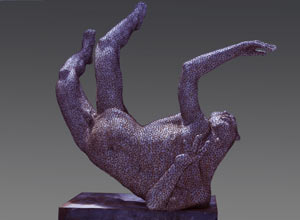Life and Leisure
Art of survival
By Zhu Linyong (China Daily)
Updated: 2010-10-01 08:10
 |
Large Medium Small |
|
|
|
|
Artists from some 90 countries and regions mull the future of mankind at the 4th Beijing International Art Biennale. Zhu Linyong reports
German artist Tobias Marx's installation Teethburger may be small but packs a punch in its message that "capitalism is symbolized by fast food, which is threatening to eat us".
"When it comes to environmental concerns and human existence, I have a lot to say," says the noted artist.
So, it appears, do artists from about 90 countries and regions whose 562 works are on display at the National Art Museum of China, as part of the ongoing 4th Beijing International Art Biennale.
Marx says man's insatiable quest for profits has led to disastrous results and environmental and ecological crises now loom large.
The theme of the 2010 Beijing Biennale - environmental concerns and human existence - was well received by artists around the world, says Wu Changjiang, vice-chair of the Chinese Artists Association, a key organizer of the event.
The displayed works have been picked by a panel of judges comprising Chinese and foreign curators, art critics and senior artists.
While some participating artists eulogize nature through their poetic or idyllic visual representations, "more are trying to warn mankind about the worsening environment", Wu says.
For instance, young Chinese artist Deng Ke's painting portrays a man lying on parched land, his hands outstretched.
|
|
The huge oil painting We Have No Choice, by Vietnamese artist Ho Minh Quan, depicts a group of people in their polluted village.
Mexican artist Angel Martinez questions the rapid development of society driven by science and technology, in his oil work Falling, which shows a burning aircraft engine crashing.
"I am not saying development is bad or wrong but human greed and selfishness have caused a sharp deterioration in the ecosystem," says Ryu Ilji, a South Korean artist whose oil work The Resurrection of Life expresses her hope for a new balance between man and nature.
"Nature has lost its balance and is taking revenge on us through shocking disasters. The situation is very disturbing," she says.
This year's Biennale also includes two special exhibitions from Austria and Chile.
Presenting more than 30 cutting-edge contemporary artworks in various genres, the Austrian exhibition provides some insight into how young artists are exploring the contemporary reality, says curator Karin Simmer.
The Chilean Special Exhibition, meanwhile, has a more personal dimension to it, according to curator Patricio M. Zarate.
Some of the works are by survivors of the earthquake and ensuing tsunami that struck Chile on Feb 27, 2010, and reflect their personal experiences.
Nicoloas Saez's Water Line Marks displays a collage of photographs of the walls of buildings destroyed in the disaster and purports to show how unpredictable nature can be.
In her untitled conceptual/installation work, Carolina Maturana presents shoes collected from river banks in Chile, to express her concern about the unemployment facing traditional fishermen with the development of trawling that has exhausted coastal resources.
"The global economic order only obeys free market rules and is oblivious to environmental regulations," the artist says.
Li Shujie, a visitor from Tianjin, is clearly impressed with the exhibition. He says it will certainly help raise awareness of environmental protection.
It will act as a bridge between people from different nations, says young French artist Frederique Trey, who is participating in the Biennale for the first time with a mysterious acrylic-on-canvas work titled Sidereal.
She says this trip to Beijing is a golden chance to see a rapidly changing China, one that is very different from what she had imagined or learned from the media.
|
 A girl is attracted by Chinese artist He Qiang's sculpture Inrush which features a swarm of cars from a cage. [Yang Xiaoqing / China Daily] |


